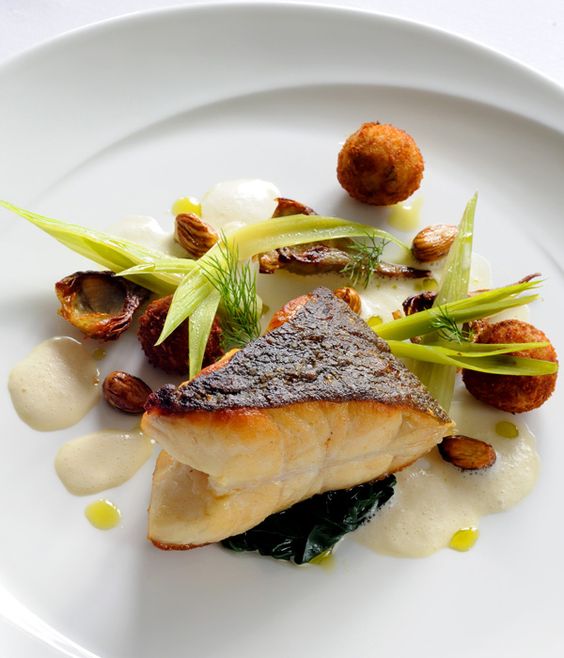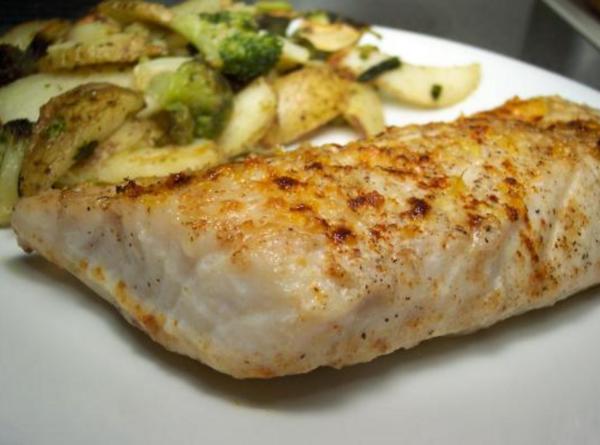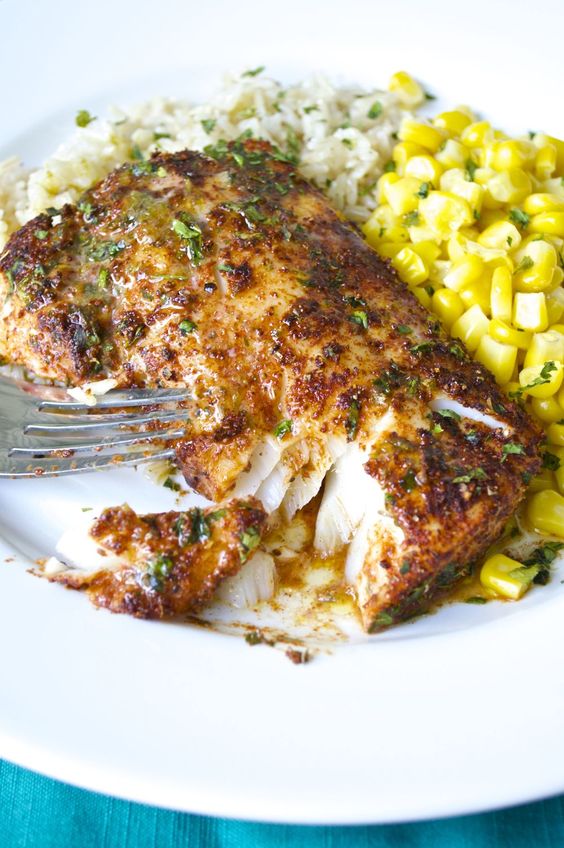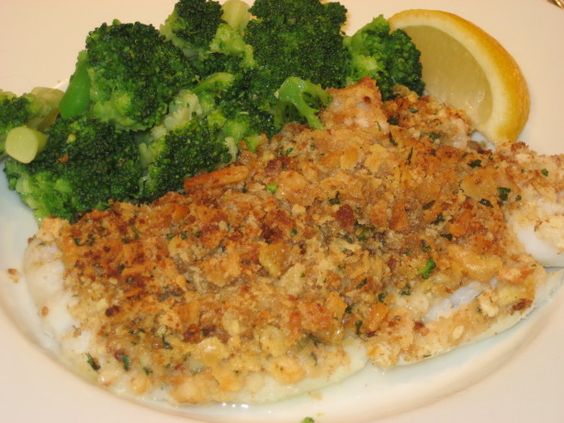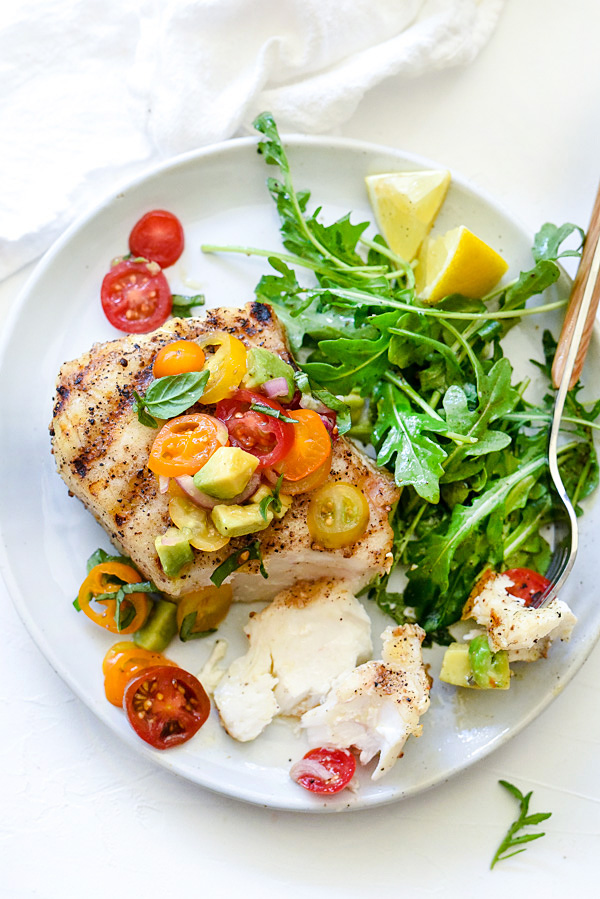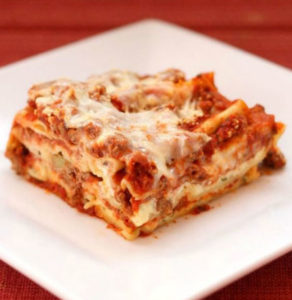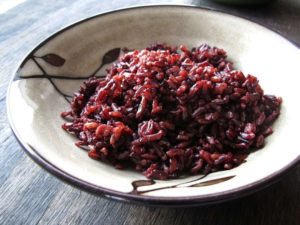We love halibut! It is an incredibly versatile fish that is available year round and has a firm, satisfying texture with a mild flavor that makes it an excellent vehicle for sauces.
Halibut takes on a beautiful white color once it is cooked and has a fantastic nutritional profile: it is high in protein, provides a number of important minerals such as selenium and has a low fat and calorie content.
The absence of bones makes halibut incredibly easy to handle and safe to eat, especially for children, and its flaky texture has turned it into a prized choice for sushi and ceviche.
Learning a way to cook halibut could be fairly clear-cut. Halibut can be cooked in many ways and it is quickly prepared. In addition to the simplicity in cooking halibut, the taste is delicate, thus it will please virtually any crowd. Whether is baked, fried, or grilled, halibut is a great addition to any meal.
More...
What is Halibut?
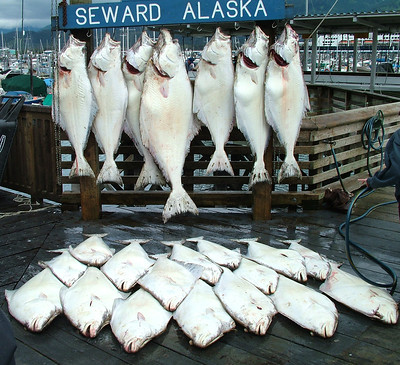
If you’ve never seen an actual halibut: prepare to be amused. It is quite a unique-looking fish.
Halibut is the largest member of a family of fish that includes sole and flounder known as flatfish and, as the name implies, they are flat-shaped creatures.
Flatfish are predators that spend most of their lives on the seafloor where they will use their thin shape to lie flat on their side and camouflage against the sand where they will quietly wait for unsuspecting prey to approach them.
Like all flatfish, halibut starts out swimming upright, with its eyes on either facet of its head.
During their development from larvae into adults, one eye slowly migrates to the opposite facet, so that it ends up directly above the other. Therefore, the fish swims in an increasing tilt and both eyes can be used when lying sideways on the ocean floor. Thus, enabling the halibut to spend lots of time buried flat within the sand, to cover and kill the creatures that swim higher.
Halibut has firm, tight-grained white flesh and exhibit different skin colors on each one of their two sides: the side which is exposed while they are camouflaging is dark brown while the underbelly is a pale white.
Their scales are tiny, and so is the mouth, with sturdy teeth on each side of the jaw. The flesh is white, meaty and delicious. Thus, the succulent meat is well worth the investment of your time and work.
What To Consider When Fishing Halibut
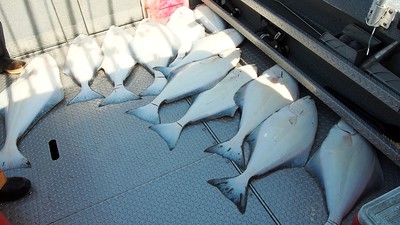
The Mediterranean diet approves of the halibut because it is a nutrient-dense fish. It has lots of macromolecules and you will be able to use it to substitute for chicken. It is also rich in minerals like potassium, phosphorus, magnesium, and selenium. Additionally, it has good amounts of vitamin B, niacin, and omega-3 fatty acid. If you live in coastal areas, you will find this article helpful in guiding you to the fundamentals of catching a halibut.
1. Use a Sturdy Boat
If you've got the intent of catching halibut, use boats which will handle massive fish and storminess. The boat should have ample power and should have a secondary engine in case of the event that your main or primary engine breaks down.
If your fishing boat is anchoring, it should have enough anchor pulpits in order to do the anchor pulling activities. Furthermore, keep in mind the built of the boat. Most halibut fishers prefer metal boats instead of fiberglass boats for halibut fishing, since the boat will certainly take abundant abuse.
The fishing rod you wish to use should be short with significant action. You would like robust lines and rods to assist you to retain the halibut throughout the tugging battle after you catch one. Though some halibuts don't fight back, most halibuts can swim deeper and you will have issues reeling them out of the water if you utilize low-cost and low-end lines and rods.
2. Consider the Moon and the Tide
The moon and the tide have an effect on the visibility or presence of the fish. A full moon causes higher and quicker tides and this can make it tough for your baits to remain at the lowest. Halibuts are bottom fishes and you wish to make sure that your baits reach their location. This doesn't mean that you won't be ready to catch a halibut if you fish throughout a full moon. It solely implies that you need to adjust your techniques accordingly. Throughout the full moon, it is suggested to anchor the boat to get a gradual state and use significant baits like salmon heads.
3. The Location and Time
According to consultants, the best season to go fishing for halibut is throughout early spring. It is the time of year when the halibuts move inshore to feed on marine life. If you wish to get a trophy halibut, you will have to travel deep within the ocean, since prized halibuts will live up to 1,000 feet underneath the water. Several people claimed that these are the tastiest halibuts. However, you will be able to catch halibuts as shallow as 30 feet deep and these halibuts are also great-tasting. Take note that the larger the halibut, the tougher it will be for you to pull it out of the water.
Big halibuts are found in the deep water during the month of July and they pull back to shallow waters in August. Consequently, the best time of the day to go fishing for halibut is about an hour before the tide goes out. As you will have discovered, the tide and state of the moon can play a vital role in halibut fishing and you will want to get to the proper location at the proper time.
What You Need To Know About Halibut

There are a couple of different types of halibut but the most important ones for you to know and the ones that you are most likely to encounter in menus and supermarkets are Atlantic halibut and Pacific halibut. They respectively inhabit the coasts of the North Atlantic and the North Pacific Ocean.
On the Atlantic side, their territory extends from the northern US East coast all the way up to Canada, Greenland’s southern coast and the North Sea in between Norway and Iceland.
Pacific halibut extend from the coast of Northern California all the way up to Alaska and the Aleutians and across to Russia’s eastern coast and Japan.
Atlantic halibut have a more defined diamond shape and are considerably larger than their Pacific-dwelling siblings. They are currently endangered because of over fishing and therefore off-limits to commercial fisheries.
Pacific halibut are mostly caught wild off the coast of Alaska, where there are higher concentrations of them.
Things To Consider When Buying Halibut

Halibut is accessible year-round. However, Spring through Fall is the best time to consume it as it is more abundant between March and November.
Pay attention to the type of halibut you get. The Atlantic halibut population has been steady declining, so it should be avoided.
Pacific varieties, which are commonly sold under the names of California or Alaska halibut, are better and safer choice because they enjoy a colder habitat and are mostly caught wild. Also, they are the most suitable option when it comes to following property fishing practices. California halibut is okay, as long as it wasn't caught with fishing net.
Since it is such a large fish, halibut is normally sold in fillets and its cheeks, which resemble large scallops, are considered to be a delicacy.
When purchasing fresh, look for glossy taut and firm flesh that looks translucent to greenish color and moist. The smell should never be fishy and the flesh should be free of spots and speckles. Avoid any with red or yellow discoloration on the lowest facet.
Halibut skin is quite thick and not very pleasurable to eat so if the skin has not already been removed have your fishmonger do it for you or do it yourself later on. The roe, liver, and cheeks of the halibut are all edible. Therefore, the bones are nice for stock.
One important thing to watch out for when choosing fresh halibut is chalky flesh. This condition gives the flesh the appearance of already having been cooked and having a stiff texture.
Scientists are not completely sure of what causes chalky skin in halibut but there are theories that link it to warmer temperatures in their waters and to lactic acid buildup from individuals that have gone through especially strenuous catching processes.
Chalky flesh will not manifest immediately: it takes a couple of days for it to show up and it can show up in frozen varieties after thawing. However, this doesn’t mean that the fish is dangerous to eat but it is an indicator of low quality so steer away from it whenever you encounter it.
Proper Cooking, Handling and Storage
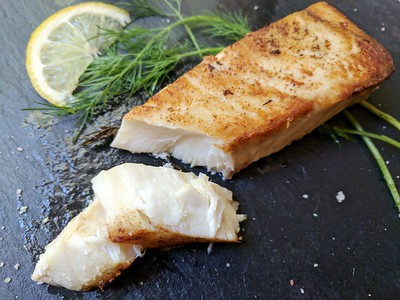
Halibut has a firm and flaky flesh that gives it a very satisfying mouthfeel and a sweet, mild flavor that pairs well with nearly every sauce and flavor you may want to experiment with.
It can be baked, broiled, grilled, barbecued, or fried. The strategy of cooking halibut depends on what flavor you are attempting to attain. If you are seeking a lightweight, delicate flavor, the broil, broiling, or baking routes would be the best choices. A heavier, fuller flavor can result if you barbecue or fry the halibut.
Despite of you not being an experienced cook, learning a way to prepare halibut can be a straightforward and pleasurable experience.
The most important aspect of cooking fish is to grasp the variations in style, texture and bone structure. A fish with an oily, rich flesh and a firm texture like salmon is entirely different from a soft, white, flaky rough fish like sea bream. When you are cooking fish, it is necessary that you handle it safely and choose sensible cooking plan to ensure you make healthy, safe, and engaging meals.
It can be a little tricky to cook halibut as its low fat an moisture content make it quite easy to overcook and then take on a dried out and chewy texture. Therefore, we recommend you err on the side of under cooking and allow the process to continue off the heat.
Most people find frozen halibut to be even drier and easier to overcook than fresh ones because it is already quite a lean fish and it loses even more moisture in the freezing process. So, you definitely want to adjust your cooking method to one that infuses it with moisture, such as steaming or cooks it in a way that reduces further moisture loss such as battering and deep frying if you go for a frozen variety.
Cooking Fresh Halibut
Fresh halibut is a sturdy and versatile fish that can withstand most cooking methods: baking, pan frying, grilling, poaching or deep frying and will keep tender as long as it is not overcooked.
It can be stored within an icebox for about thirty-six hours and if you buy it fresh and freeze it, it will keep for about 6-8 months.
These are some of our favorite ways to prepare it:
Blackened Halibut with Mango-Avocado Salsa
Blackened Halibut with Mango and Avocado Salsa
Grilled Halibut with Lemon-Basil Vinaigrette
Grilled Halibut with Lemon-Basil Vinaigrette recipe | Epicurious.com
Halibut Ceviche with Tomato and Pineapple
Halibut Ceviche with Tomato and Pineapple recipe | Epicurious.com
Grilled Halibut with Korean BBQ Sauce
Grilled Halibut, Eggplant, and Baby Bok Choy with Korean Barbecue Sauce recipe | Epicurious.com
Broiled Halibut with Miso Glaze
Nina Simonds’s Broiled Halibut With Miso Glaze Recipe - NYT Cooking
Cooking Frozen Halibut
Frozen halibut is drier than fresh one, so opt for cooking methods that use water such as steaming or baking en papillote or techniques that keep moisture in with a protective coat such as deep frying.
When the halibut is purchased commercially frozen, it will keep for about 10-12 months and like many other frozen fish, you can simply cook the fillets without needing to defrost them.
This technique works best if you plan on baking or frying the fish. For different types of preparation, defrosting the halibut would be a much better choice. Thus, deciding which way to cook halibut is the main factor that will dictate whether the fish should be thawed or not.
If you decide to thaw the halibut, then it is best to remove the fish from the freezer the night before and let it thaw in the refrigerator. However, if you need to defrost it faster, you can place the vacuum sealed fish in a bowl and run cool water.
These are some of our favorite ways to prepare it:
Steamed Halibut with Ginger
Steamed Halibut with Ginger Recipe | Leite’s Culinaria
Tempura Halibut with Garlic Aioli
Tempura Fried Halibut With Garlic Aioli Recipe
Sake-Steamed Halibut with Ginger and Cabbage
Sake-Steamed Halibut with Ginger and Cabbage Recipe - Grace Parisi | Food & Wine
Halibut Fish and Chips
Halibut Fish and Chips with Market Street Tartar Sauce | Barbara Bakes
Halibut and Summer Vegetables en Papillote
Halibut and Summer Vegetables en Papillote Recipe - Nikole Herriott | Food & Wine
Substitute For Halibut
Halibut’s large size, its odd shape along with its preferred habitat near the sea floor and notable strength make it a tough fish to catch. This, in turn, drives up the price-per-pound.
Halibut can also be tough to find in certain areas either because they are too far from sources or because people are not familiar with it. There are, however, plenty of affordable and more readily available substitute options for halibut.
When you go buy the necessities in the market, it turns out that something is not available. What are the possible substitutes for halibut?
In this section, you will find out the best substitutes for halibut:
1. Flounder
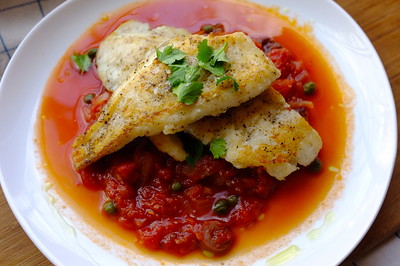
Flounder is a type of flatfish, just like halibut. There are around 30 species of flounder that can be found in the Atlantic and Pacific Ocean. Some types of flounders can be found on a depth of 35.000 feet, but it usually lives near the coral reefs, bridge piles and docks.
Because it is also a flatfish, some people will float flounder and sole as possible substitutes for halibut.
However, keep in mind that both flounder and sole have a flavor and texture profile that are nearly opposite from halibut. With sweet and extremely tender meat, they will not perform well in cooking situations that require grilling, for example.
Their flaky flesh is incredibly delicate in flavor and remains moist once cooked. Thus, the best way to prepare flounder is to broil, bake, fry pan, fry or poach.
2. Turbot
The turbot is a member of the flatfish family found primarily in sandy shallow waters near the shore. It a dark-green brown to black prime and is incredibly similar in look to flounder and sole. In Europe, turbot is raised in fish farms. However, these are much smaller, averaging about 2 to 4 pounds. It is typically sold as frozen fillets within the US. Like other flatfish, its fillets are white and delicate in flavor with a moderate fat content.
Turbot could be a tremendous fish. It is not low-cost; however, the flesh is firm and attractive. Once buying this fish, bear in mind that the flesh of a turbot turns blue once the fish is stale.
This fish is accessible all year round in fillets or steaks, yet as a whole, and you will be able to grill or poach it. A sauce or parsley sauce is particularly mouthwatering with turbot. The turbot has meat that is delicate and tender, therefore the best way to cook is to bake, steam, sauté, pan fry or poach.
3. Striped Bass
The striped bass are anadromous, which means that they spend their adult lives in the ocean and then return to freshwater to spawn. Because its population is below target levels, it is protected by law from industrial fishing. Generally referred to as squid hound, rockfish, greenhead, striper, linesider or pinfish, the striped bass is light green, olive, steel blue, black, or brown on top with a silver belly and has seven or eight dark horizontal stripes.
It averages between 2 to 50 pounds, however, has been known to achieve one hundred twenty-five pounds and 6 feet long. It is the state fish of Maryland, Rhode Island, and South Carolina.
The striped bass has a firm flesh that is delicate, nonetheless tasty. Its texture and flavor is very similar to halibut, which makes it a great substitute for it. The best way of cooking is to bake, broil, pan fry, oven fry, sauté, poach or grill.
4. Cod
Cod fish is one of the most consumed fish in the US, particularly on the east coast. As such, it is served in several restaurants from Maine to Florida. People in those regions associate fish with cod. That is why it makes such an exquisite fish to cook at home; it is acquainted. And by using an acquainted style for dinner guests, maybe, you are then pushed to change things up when cooking the fish, to stimulate everybody's palate and create a really pleasing meal.
Additionally, cod is out there year round. The cost is also comparatively stable, only fluctuating shortly after harsh weather, like storms. You can buy fresh cod at just about any market. You will be able to even go right to the docks if you reside close to the ocean, and make deals for a product that just came off the boat.
Cod is a very versatile fish. Its flesh is flaky and goes well with a great amount of ingredients. Whereas baking is great and customary way of cooking the fish, all the other cooking methods will work. It can be baked, poached, sautéed, and fried.
5. Haddock
The haddock is a member of the cod family found within the cool waters of the Atlantic. It lives on the deep ocean floor and is incredibly important to industrial fishermen. Haddock has purplish color on top with a lighter belly and it is recognizable by a dark stripe along its body and a black spot above its pectoral fin.
They weigh about 3 pounds. However, they grow to thirty-seven pounds and forty-four inches long. Little haddock are typically split in the center and marketed as scrod. Haddock have a chewy superimposed flesh that is very delicate in flavor and low in fat. The best way to cook haddock is to bake, broil, oven fry, steam, pan fry sauté or poach.
Choosing A Better Option
Currrently, there is a massive amount of food dishes offered from plain to classy, old-fashioned to modern, while being influenced by cuisines from the four corners of the planet.
A totally different variety of food is custom-made to nearly each conceivable cooking methodology and a really sizable amount of inventive techniques is concerned in their preparation. The sole challenge posed is by the care with that it should be cooked.

